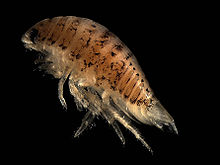Isopods
| Isopoda Temporal range: 300–0 Ma |
|
|---|---|
 |
|
| Eurydice pulchra, a carnivorous isopod found on sandy shores | |
| Scientific classification | |
| Kingdom: | Animalia |
| Phylum: | Arthropoda |
| Subphylum: | Crustacea |
| Class: | Malacostraca |
| Superorder: | Peracarida |
| Order: |
Isopoda Latreille, 1817 |
| Suborders | |
Isopoda is an order of crustaceans that includes woodlice and their relatives. Isopods live in the sea, in fresh water, or on land. All have rigid, segmented exoskeletons and most are grayish or whitish in color. They have two pairs of antennae, seven pairs of jointed limbs on the thorax, and five pairs of branching appendages on the abdomen that are used in respiration. Females brood their young in a pouch under their thorax. Isopods have various feeding methods: some eat dead or decaying plant and animal matter, others are grazers, or filter feeders, a few are predators, and some are internal or external parasites, mostly of fishes. Aquatic species mostly live on the seabed or bottom of freshwater bodies of water, but some more derived taxa can swim for a short distance. Terrestrial forms move around by crawling and tend to be found in cool, moist places. Some species are able to roll themselves into a ball to conserve moisture or as a defence mechanism.
There are over 10,000 species of isopod worldwide, with around 4,500 species found in marine environments, mostly on the seabed, 500 species in fresh water, and another 5,000 species on land. The order is divided into eleven suborders. The fossil record of isopods dates back to the Carboniferous period (in the Pennsylvanian epoch), at least 300 million years ago, when isopods lived in shallow seas. The name Isopoda is derived from the Greek roots (, meaning "same") and (pod-, pous, meaning "foot").
...
Wikipedia
